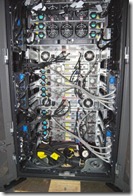The First Private Cloud Appliance
What’s inside the new HP Enterprise Database Consolidation Appliance?
 On Sept 13th, we launched the new HP Database Consolidation Appliance which supports deploying 1000’s of workloads in a private cloud infrastructure. The solution is specifically designed for I/O intensive workloads and can load balance a complex mix of workloads across multiple racks that are required in a true private cloud appliance deployment.
On Sept 13th, we launched the new HP Database Consolidation Appliance which supports deploying 1000’s of workloads in a private cloud infrastructure. The solution is specifically designed for I/O intensive workloads and can load balance a complex mix of workloads across multiple racks that are required in a true private cloud appliance deployment.
I’d like to spend a few minutes talking about my favorite aspects of the appliance.
The First Private Cloud Appliance – Factory Built
It takes an imagination to really grok what we mean by “factory-built” appliance. It is easy to imagine that the hardware is racked, powered, and wired, but one of the key investments we’ve made in the factory process working with HP is to make sure the software is installed and configured in the factory. What does that mean? It means when the appliance is first powered up, it is an operational multi-server Hyper-V failover cluster. You won’t see some BIOS screen asking for boot media, or a sysprep’d OS asking pre-installation information, rather the appliance is functional pending security and network configuration to complete the delivery process. The complex configuration of the host environment, management software components, and private cloud infrastructure has been completed in the factory. That means customers can expect a consistent appliance experience when they take delivery of their private cloud appliance. We believe this especially important given the complexity of the appliance which integrates more than 25 software components.
Elegant, High-Performance, Cost-Effective Hardware
One of my favorite aspects of the appliance is how well we evolved the hardware solution. The finished solution changed from what we initially expected and in fact we were able to eliminate 12 switches and more than a hundred cables per rack in the final design. Here’s a picture of what would be a ½ rack or the bottom of a full rack appliance.
 If a customer were to build this out of typical 2U servers, there would be somewhere around 18-20 cables per servers connected into 8 different pairs of switches – the appliance design eliminates a rat’s nest of cables without compromising performance. In the end we developed a more reliable, serviceable appliance that supports a scale-out model. It also is optimized so that upgrading a ½ rack to a full rack requires ZERO new cables to the servers; simply connect the storage blocks together and to the storage switch. To me that is “Elegant” enterprise systems design.
If a customer were to build this out of typical 2U servers, there would be somewhere around 18-20 cables per servers connected into 8 different pairs of switches – the appliance design eliminates a rat’s nest of cables without compromising performance. In the end we developed a more reliable, serviceable appliance that supports a scale-out model. It also is optimized so that upgrading a ½ rack to a full rack requires ZERO new cables to the servers; simply connect the storage blocks together and to the storage switch. To me that is “Elegant” enterprise systems design.
Scale-out Design
The elegant hardware design also allows a scale-out architecture. Not only can a customer purchase a ½ rack as a starting point, that ½ rack can be upgraded to a full rack without shutting down the running appliance. Additional racks can be added and for customers with substantial needs they can even put many racks into an HP POD – a container-based datacenter with the opportunity to add custom L2 network and optional UPS infrastructure. You can think of this private cloud appliance as supporting a “thin provisioning” model – you can buy as much as you think you need and add more if you need to, when you need to. This is an interesting attribute, for some customers it means they can start with a ½ rack without knowing exactly what they need, use the built-in tools to help size their workload needs and then add capacity as needed when needed.
Well that covers my short list. If you want to learn more take a look at this video.
D. Britton Johnston
Principal Group Manager
SQL Server Appliance Engineering Team
Twitter: @brittjohnston

